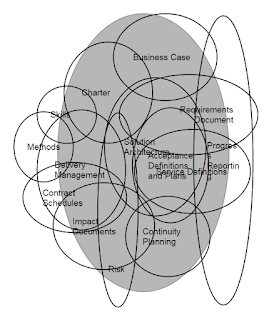The problem is largely that the information is tied up in documents associated with a silo view of activities.
To make matters worse this set of documents takes a lot of work to create and includes things that are highly connected. So firstly when done manually it is extremely difficult to do well, very tedious to try and analysis (e.g. or completeness etc.) and soul destroying to try and maintain. This usually means it is poorly done. It also looks a lot of work - where the size of each ellipse below is an indication of effort
However by having the information in a common shared repository we can manage all the information failing easily, produce all the documents, and we actually do real analysis. When we look at each document we realise that there is a very overlap,
So we can substantially reduce the effort required i.e.
And we ensure integrity, we can reuse data from other sources explicitly and we do the analysis that is really needed
To provide other adhoc ways of understanding relationships we can use our SoA extensions to make the information paths available via standard BI tools, or via graph databases so that connections can be examined.











